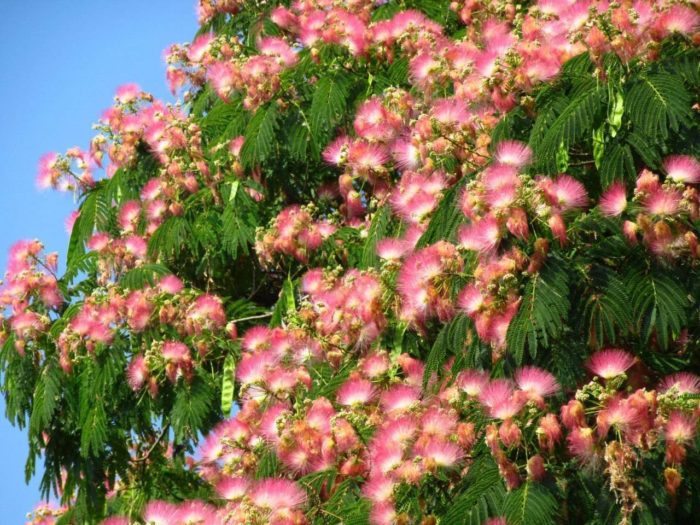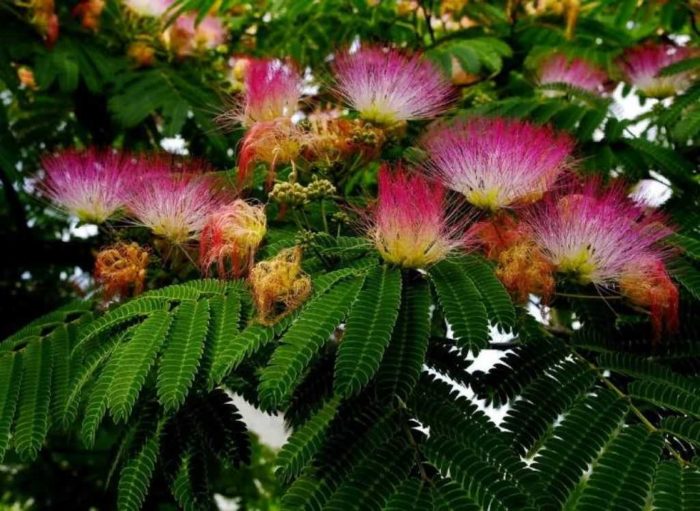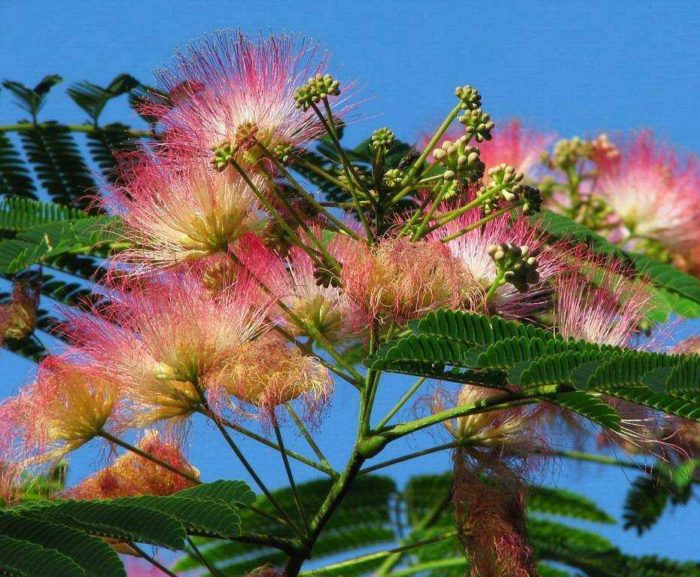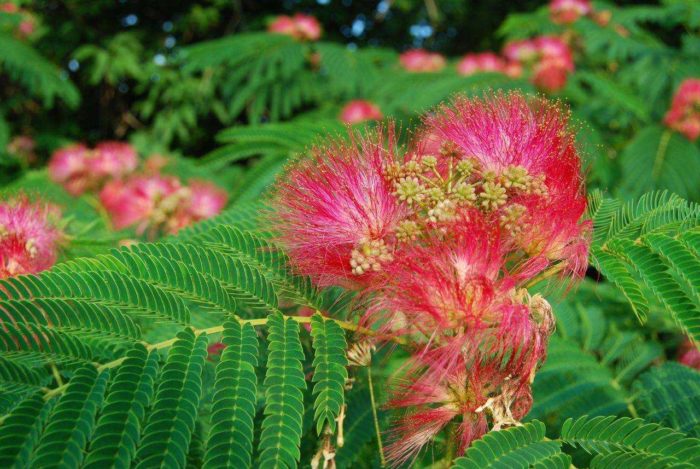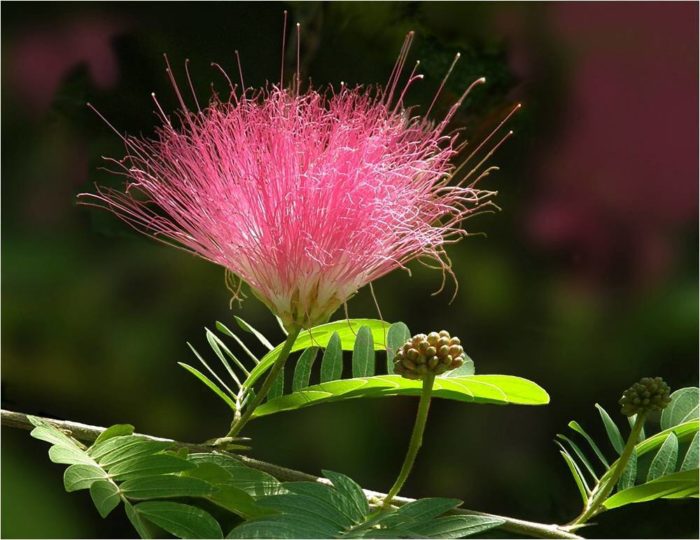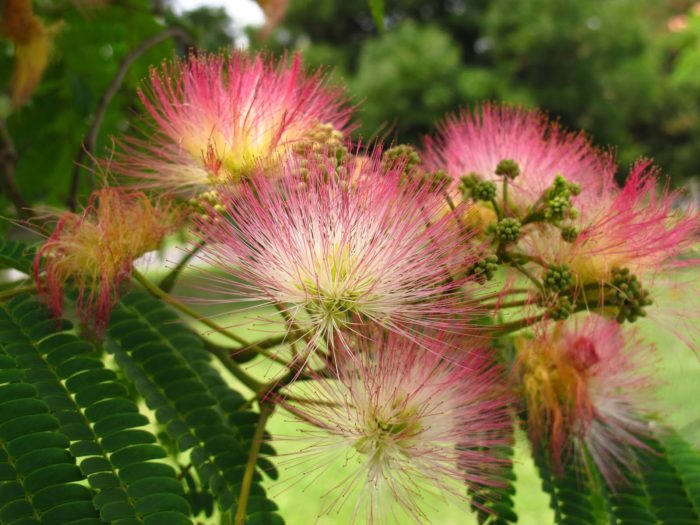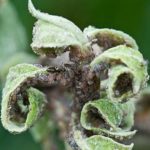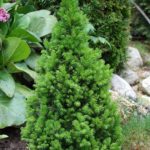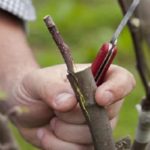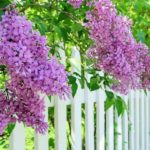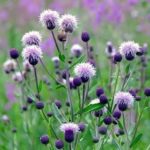A beautiful tree, related to mimosa, naturally grows in the tropics and subtropics, but albizia can be grown in a temperate climate if you know the secrets of cultivation and care. The plant cannot be called capricious; it is often chosen for creating greenhouses and gardening compositions. For gardeners who dream of planting albizia in their garden plot, we present a description of the tree with detailed instructions for growing from seeds and caring for it.
- Characteristics of Albizia
- Places where albizia grows
- Varieties of albizia
- Albizia Lankaran
- Albizia fasciculata
- Albizia adobe
- How to grow Albizia from seeds at home
- Planting Albizia seeds
- Temperature and lighting requirements
- Albizia watering rules
- Care and feeding of albizia
- Transplanting an albizia plant
- Albizia crown formation
- Growing Albizia in the garden
- Diseases and pests of albizia
- Albizia propagation methods
Characteristics of Albizia
Albizia (Latin systematic name - Albizia) is a highly decorative representative of the Legume family. In fact, it is a type of acacia, a deciduous tree or, less commonly, a large shrub. The plant branches heavily, grows up to 10 m in height, the diameter of the lush and spreading crown can reach 7 m. The trunk is straight, not exceeding 50 cm in width, covered with gray bark with a slight roughness.
The leaves have a complex shape, reach 20 cm in length, and are small leaf plates located opposite each other, the number of which on the petiole can reach up to 30. The leaf color is mostly green, although some varieties are greenish-brown or grey-violet. The peculiarity of the leaves is the ability to fold like a book at nightfall.
The root system also has an interesting feature. Nodule receptors are formed at the ends of the roots. Bacterial microflora multiply in them and are capable of capturing nitrogen entering the soil. That is, the roots of albizia are capable of actively absorbing and accumulating nitrogen compounds in their tissues, so the soil under this tree is always enriched with nitrogen.
Albizia releases allelopathic substances into the soil that inhibit the development of neighboring plants. Therefore, even ordinary grass grows weakly around this tree.
The tree blooms in May and June. The paniculate inflorescences contain a large number of thin lilac-colored stamens. The flowers are bisexual, honey-bearing, attractive to bees. They smell soft and sweet.Depending on the variety, the color of the flowers is lilac-pink, white, cream or pale yellow. After flowering is complete, green-brown fruits are formed. They are no more than 18 cm in length; inside there are beans with a diameter of 1 cm.
Places where albizia grows
The tree prefers to grow in areas with a mild and warm climate. The natural range of Albizia extends to Asia Minor, Transcaucasia, the coast of the Caspian Sea, southern China, and the Hindustan Peninsula. Significant populations of the species are observed in Turkey, Iran, Azerbaijan, and Thailand. On the territory of Russia, Albizia can grow wild only on the Crimean Peninsula and the shores of the Black Sea.
Today, the artificial habitat of albizia as an ornamental plant for landscape gardens has expanded significantly. It is successfully grown where the climate is mild and moderately warm all year round: in the Mediterranean region, in some states of the USA, in Japan. Moreover, in the United States the tree has already been recognized as an aggressive invasive species, since under favorable climatic conditions it began to actively reproduce in the wild. And the Japanese have learned to create miniature Albizia bonsai.
Varieties of albizia
There are several varieties of albizia, and almost all of them are decorative and suitable for landscape design. The most popular varieties are described below.
Albizia Lankaran
Another name for the variety is Pompadour. It is also called silk acacia for its fluffy large flowers with pink or cream stamens. This is a tall, spreading tree. The foliage is beautiful, forming an openwork crown, the leaf plates on the front side are rich green, on the bottom - faded green. Budding begins in June, flowering under comfortable conditions lasts until September.
| pros | Minuses |
| long and lush flowering
rapid growth - 80 cm per year life expectancy up to 100 years ability to tolerate prolonged drought resistance to dust and urban air pollution |
demanding on soil quality, humus content and acidity
low frost resistance of shoots - maintained down to -16°C |
Albizia fasciculata
This is a compact shrub, not exceeding 4 m in height. It blooms in small spike-shaped inflorescences up to 8 cm long, the flowers are cream or light yellow. Has fleecy stems. It is distinguished by spring flowering: buds form in the second half of March. Flowering lasts about 2 months.
| pros | Minuses |
| early flowering
abundant formation of inflorescences maintaining high seed germination for more than 5 years |
tendency to drop leaves at the slightest adverse weather conditions
|
Albizia adobe
This is a large, massive tree with a wide and spreading umbrella-type crown. The leaves are wide, bright green. The inflorescences are red or dark pink in color and smell delicate and soft. This species is widely used for landscaping city squares and parks.
| pros | Minuses |
| attractive crown shape
fast development long lasting and unusually beautiful flowering |
low frost resistance - withstands down to -13°C |
How to grow Albizia from seeds at home
You can grow Albizia not only in open ground, but also at home in a flower pot. This method of cultivation is optimal for temperate climates, where winters are too cold for this plant. True, in indoor conditions the tree grows to a maximum of 1.5 m. In summer, it is recommended to take the flower pot out to the loggia, veranda or courtyard of a private house, and place it in light openwork shade under the tree crowns.
Planting Albizia seeds
Planting seeds should begin in the last days of February or early March. You need to plant it in a small container, preferably ceramic. You can take plastic cups, but later the young plants will have to be replanted.
The beans must first be stratified for 2 months; before sowing, they should be soaked for a day in warm water with the addition of a root growth stimulator. To plant seeds, you need to buy or prepare soil yourself, containing approximately ¾ of turf and leaf soil, ¼ of peat and coarse sand. Some gardeners successfully germinate seeds in agroperlite.
Then proceed like this:
- Immerse the seeds in the holes to a depth of 1 cm. Water thoroughly.
- Cover the container with polyethylene. Place it where there is sufficient light, but diffused.
- Open the plastic sheet slightly for ventilation every day.
- Moisten the soil as the surface layer dries.
- If lighting is not enough, use ultraviolet lamps.
- When the sprouts hatch, remove the plastic. This will happen approximately 2 months after sowing.
Temperature and lighting requirements
Albizia likes intense but diffused light. Direct sunlight can hit the plant, but not for long. You can’t put Albizia completely in the shade: it will wither.
Comfortable summer temperature is +20-25°C. The plant can withstand heat well up to +35°C, but only with sufficient moisture. But sharp temperature fluctuations are painful for Albizia. Therefore, when preparing a plant for winter dormancy, the temperature in the room must be lowered gradually, by 1-2°C per day. In winter, the optimal temperature in the room where the albizia is located is +8-10°C.
Albizia watering rules
Albizia is moisture-loving. It needs to be watered regularly. The optimal frequency is 2-3 times a week.The soil should always be slightly moist, but not waterlogged. Water for irrigation should be settled and at room temperature.
Care and feeding of albizia
Albizia is not capricious in caring for. You need to feed it once a month during the active growing season, that is, all the time except winter. For feeding, you should use mineral-organic complexes for ornamental flowering plants.
Transplanting an albizia plant
The young plant must be replanted annually, preferably at the end of winter. The new pot should be 2-3 cm wider than the previous one. Containers, like new soil, must be disinfected beforehand. It is best to use a dark pink manganese solution.
Carry out the transplant this way:
- Carefully remove the plant along with the soil ball from the pot.
- Carefully shake off excess soil. But in general, the soil lump should remain on the roots.
- Move the plant to a new pot with drainage.
- Fill the voids between the soil ball and the walls of the pot with fresh soil.
- Water the transplanted plant immediately.
Mature plants, older than 10 years, are difficult to replant. Therefore, in this case, they simply remove the top soil layer and put a new one in its place.
Albizia crown formation
Sanitary pruning should be carried out in the spring, before the plant begins to bloom. You need to cut off old, withered, diseased branches. You also need to remove shoots that thicken the crown. Albizia flowers form on growing shoots of the current season, so even significant pruning will not affect the abundance of flowering.
A shaping haircut is carried out only if you want to make an original crown, for example, spherical or spiral-shaped.Albizia's young shoots are unusually flexible, so it is easy to give the plant an unusual shape.
Growing Albizia in the garden
Seedlings or seeds can be planted in open ground in the spring, when the soil temperature exceeds +15°C. When sowing beans, they need to be buried approximately 3 cm into the soil. The planting hole should have drainage from small pebbles. It is preferable to plant Albizia in the southeast or southwest of the house under the shade of tall trees. The landing site must be protected from strong winds and drafts.
A tree growing on a personal plot is fed once a year in the spring before the buds form, and watered regularly. If the tree looks weak, you can feed it again at the end of the growing season. It is recommended to use vegetable humus as an organic fertilizer, but manure and other animal waste should not be added. You also need a complex mineral supplement.
Albizia is sensitive to acidic and clayey soils. The optimal soil should be light, breathable, and have a neutral pH value.
Winter in a temperate climate is a huge stress for Albizia. Without insulation, an adult tree will be able to survive a short frost no stronger than -15°C, and young seedlings die even in less cold weather. Therefore, you need to carefully cover the tree for the winter. The tree trunk circle should be mulched with a dense layer of peat, sawdust or leaf litter. Wrap the trunk and crown with a thick, breathable fabric, and cover with cardboard or thin foam sheets.
Diseases and pests of albizia
This tree has amazingly strong immunity; when favorable conditions are created, it practically does not get sick.But still, for prevention, albizia should be treated with insecticides 2 times during the growing season. Especially if the plant is in a greenhouse or indoor environment, because in this case it is more susceptible to attack by scale insects and spider mites.
In spring, growing shoots may dry out. The cause is a fungal infection. In this case, the plant must be sprayed with a fungicidal solution.
Albizia propagation methods
Albizia can be propagated by cuttings, seeds and root shoots. The above-described sowing of seeds is a complex option that requires experience.
Propagation by cuttings is also not easy. In this case, proceed like this:
- Cut cuttings 12-15 cm long from last year's apical shoots. Cut so that the top cut is horizontal and the bottom is beveled.
- Cut the leaf blades, leaving only 1/3 of their length.
- Treat the lower cut of the cuttings with a root growth stimulator according to the instructions.
- Plant the cuttings in the soil under a film cover.
- Water regularly, open the film slightly for ventilation.
Root growth by cuttings lasts up to 3 months.
The easiest way is to use root suckers, which are simply cut off from the mother plant and planted in a previously dug hole.

